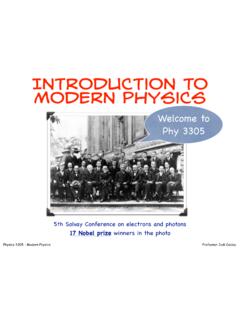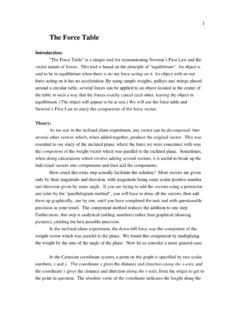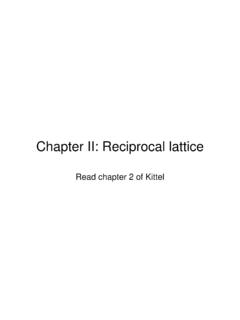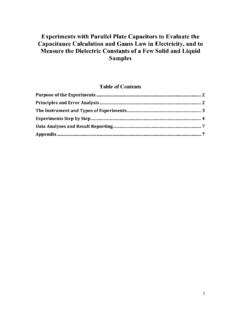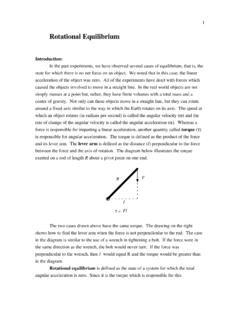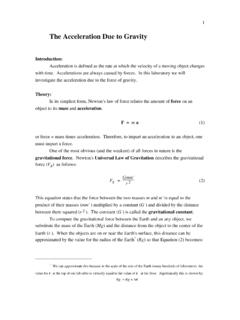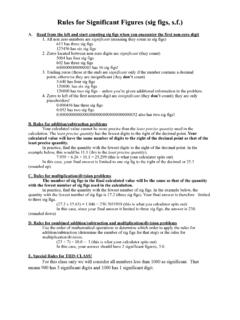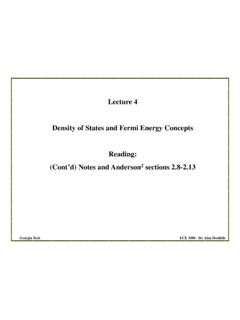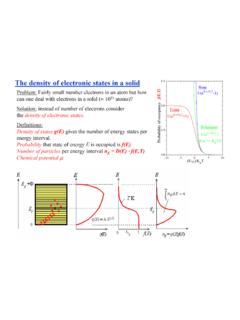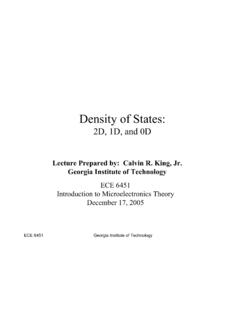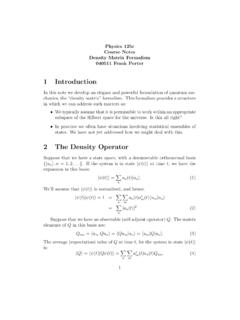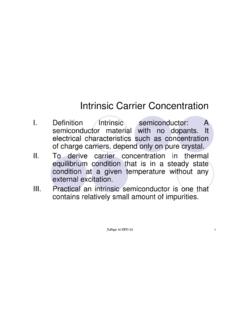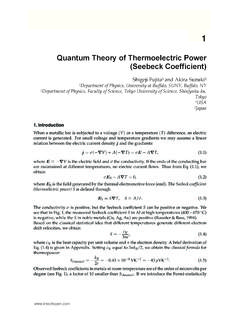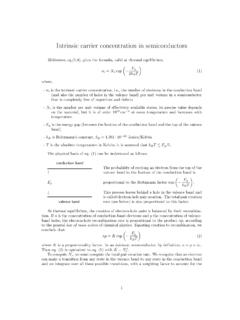Transcription of Free Electron Fermi Gas (Kittel Ch. 6) - SMU Physics
1 free Electron Fermi Gas ( kittel Ch. 6). Role of Electrons in Solids Electrons are responsible for binding of crystals -- they are the glue that hold the nuclei together Types of binding (see next slide). Van der Waals - electronic polarizability Ionic - Electron transfer Covalent - Electron bonds Electrons are responsible for important properties: Electrical conductivity in metals (But why are some solids insulators?). Magnetism Optical properties .. Characteristic types of binding Closed-Shell Binding Ionic Binding Van der Waals Covalent Binding Metallic Binding Starting Point for Understanding Electrons in Solids Nature of a metal: Electrons can become free of the nuclei and move between nuclei since we observe electrical conductivity Electron Gas Simplest possible model for a metal - electrons are completely free of the nuclei - nuclei are replaced by a smooth background -- Electrons in a box.
2 Electron Gas - History Electron Gas model predates quantum mechanics Electrons Discovered in 1897. Drude-Lorentz Model (1905)- Electrons - classical particles free to move in a box Model: All electrons contribute to conductivity. Works! Still used! But same model predicted that all electrons contribute to heat capacity. Disaster. Heat capacity is MUCH less than predicted. Quantum Mechanics 1911: Bohr Model for H. 1923: Wave Nature of Particles Proposed Prince Louis de Broglie 1924-26: Development of Quantum Mechanics - Schrodinger equation 1924: Bose-Einstein Statistics for Identical Particles (phonons, ..). 1925-26: Pauli Exclusion Principle, Fermi -Dirac Statistics (electrons, ..). 1925: Spin of the Electron (spin = 1/2) Schrodinger G.
3 E. Uhlenbeck and S. Goudsmit Schrodinger Equation Basic equation of Quantum Mechanics [ - ( h/2m ) 2 + V( r ) ] ( r ) = E ( r ). where m = mass of particle V( r ) = potential energy at point r 2 = (d2/dx2 + d2/dy2 + d2/dz2). E = eigenvalue = energy of quantum state ( r ) = wavefunction n ( r ) = | ( r ) |2 = probability density Schrodinger Equation 1D line Suppose particles can move freely on a line with position x, 0 < x < L. 0 L. Schrodinger Eq. In 1D with V = 0. - ( h2/2m ) d2/dx2 (x) = E (x). Boundary Condition Solution with (x) = 0 at x = 0,L. (x) = 21/2 L-1/2 sin(kx) , k = n /L, n = 1,2, .. (Note similarity to vibration waves). Factor chosen so 0L dx | (x) |2 =1. E (k) = ( h2/2m ) k 2.
4 Electrons on a line Solution with (x) = 0 at x = 0,L. Examples of waves - same picture as for lattice vibrations except that here (x) is a continuous wave instead of representing atom displacements . 0 L. Electrons on a line For electrons in a box, the energy is just the kinetic energy which is quantized because the waves must fit into the box E (k) = ( h2/2m ) k 2 , k = n /L, n = 1,2, .. E. Approaches continuum as L becomes large k Schrodinger Equation 1D line E (k) = ( h2/2m ) k 2 , k = n /L, n = 1,2, .. Lowest energy solutions with (x) = 0 at x = 0,L. (x). x Electrons in 3 dimensions -(h2/2m ) [d2/dx2 + d2/dy2 + d2/dz2 ] (x,y,z) = E (x,y,z). (x) = 0 at x = 0,L; (y) = 0 at y = 0,L ; (z) = 0 at z = 0,L.
5 = 23/2 L-3/2 sin(kxx) sin(kyy) sin(kzz) , kx = n /L, n = 1,2, , same for y,z E (k) = ( h2/2m ) (kx2 + ky2 + kz2 ) = ( h2/2m ) k2. E. Approaches continuum as L becomes large k Electrons in 3 dimensions - continued Just as for phonons it is convenient to define with periodic boundary conditions is a traveling plane wave: = L-3/2 exp( i(kxx + kyy + kzz) , kx = n (2 /L), etc., n = 0,1,2,.. E (k) = ( h2/2m ) (kx2 + ky2 + kz2 ) = ( h2/2m ) k2. E. Approaches continuum as L becomes large k density of states Key point - exactly the same as for vibration waves We need the number of states per unit energy to find the total energy and the thermal properties of the Electron gas. Difference: density of states is defined in terms of energy E, not angular frequency.)
6 D(E)dE - number of states in energy range E to E+dE. states in interval (k, E) to (k+ k, E+ E). N= N(k) k=N(E) E. dN/dE=(dN/dk)/(dE/dk). density of states in 3D. The values of kx ky kz are equally spaced: kx = 2 /L ,. Thus the volume in k space per state is (2 /L)3. and the number of states N with |k| < k0 is N = (4 /3) k03 / (2 /L)3 = V/6 2 k03 L3=V. The density of states per unit energy is D(E) = dN/dE = (dN/dk) (dk/dE). E = ( h2/2m ) k2 , dE/dk = ( h2/m ) k D(E) = (V/2 2) k2 / (h2/m ) k = (V/2 2) k / (h2/m ). = (V/4 2) E1/2 (2m / h2)3/2. kittel adds a factor of 2 for multiplicity of electrons in the same state (spin): D(E) = (V/2 2) E1/2 (2m / h2)3/2. Electron orbitals In 1D E (k) = ( h2/2m ) k 2 , k = n /L, n = 1,2.
7 In 3D E (k) = ( h2/2m ) (kx2 + ky2 + kz2 ) = ( h2/2m ) k2. kx, ky kz = n (2 /L), etc., n = 0,1,2,.. Thus E1D (k) = n2 ( h2/2m ) ( /L)2. E3D (k) = (nx+ny+nz)2 ( h2/2m ) (2 /L)2. To describe a system of Nelec electrons, we assign the electrons to orbitals of increasing energy, until all orbitals are filled. Order of filling: n=1, 2, .. nF. nF - topmost filled energy level ( Fermi level). Electron orbitals D(E)= (V/2 2) E1/2 (2m / h2)3/2. D(E) EF. Empty Filled E. Now we need to figure out how many electrons are on a given orbital ( Electron occupancy). What is special about electrons? Fermions - obey exclusion principle Fermions have spin s = 1/2 - two electrons (spin up and spin down) can occupy each state Kinetic energy = ( p2/2m ) = ( h2/2m ) k2.
8 Thus if we know the number of electrons per unit volume Nelec/V, the lowest energy allowed state is for the lowest Nelec/2. states to be filled with 2 electrons each, and all the (infinite) number of other states to be empty. The number of states with |k| < k0 is N = (V/6 2) k03. (from before). Fermi momentum and energy Thus all states are filled up to the Fermi momentum kF and Fermi energy EF = ( h2/2m ) kF2, given by Nelec/2 = (V/6 2) kF3.. kF = (3 2 Nelec/V )1/3 and EF = (h2/2m) (3 2 Nelec/V )2/3. Reciprocal space Filled states Possible k values Fermi surface in 2D. Fermi Distribution At finite temperature, electrons are not all in the lowest energy states Applying the fundamental law of statistics to this case (occupation of any state and spin only can be 0 or 1) leads to the Fermi Distribution giving the probability that an orbital of energy E is occupied ( kittel appendix).
9 F(E) = 1/[exp((E- )/kBT) + 1]. Chemical potential for electrons =. f(E) Fermi energy at T=0. 1. D(E). 1/2 is temperature kBT dependent E. Ex. How does the Fermi distribution f(E) = 1/[exp((E- )/kBT) + 1]. compare with the Planck distribution for phonons? n(E) = 1 / [ exp ( E / kB T) - 1 ]. Sketch them as a function of energy for different temperatures. Typical values for electrons? Here we count only valence electrons (see kittel table). Element Nelec/atom EF TF = EF/kB. Li 1 eV x104 K. Na 1 x104 K. Al 3 eV x104 K. For typical metals the Fermi energy temperature is much greater than ordinary temperatures transition from f(E)=1 to f(E)=0 is sharp at room temperature Heat Capacity for Electrons Just as for phonons the definition of heat capacity is C = dU/dT.
10 Where U = total internal energy When heated from T=0 only electrons within an energy range kBT of the Fermi energy can be excited thermally For T << TF = EF /kB roughly U ~ U0 + Nelec (T/ TF) kB T so that C = dU/dT ~ Nelec kB (T/ TF). Chemical potential f(E) for electrons 1 D(E). kBT. 1/2. E. Heat Capacity for Electrons More precisely, the change in energy when heated from 0 to T is U = dE E D(E) f(E) - . EF. 0 0 dE E D(E). Using the fact that T << TF: C = dU/dT = 0 dE (E - EF) D(E) (df(E)/dT).. D(EF) 0 dE (E - EF) (df(E)/dT).. The integral can be done almost exactly (exact in the low T limit) to give C = ( 2/3) D(EF) kB2 T (valid for any metal). ( 2/2) (Nelec/EF) kB2 T (for the Electron gas).
